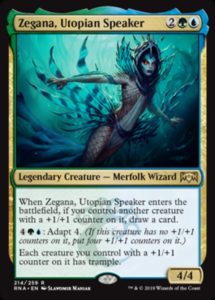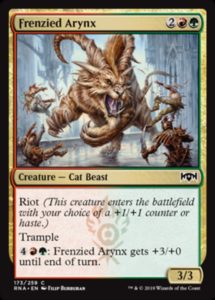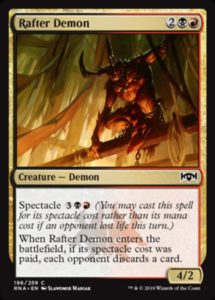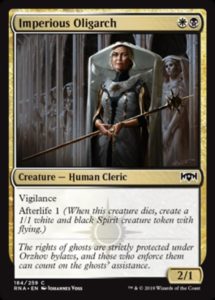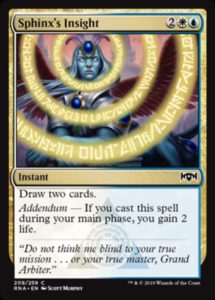Happy holidays, everyone! Hopefully you’re all having Merry Christmases, eating Chinese and watching a movie like me, or doing whatever else you enjoy on this random day in December. Last week we were treated to the five Ravnica Allegiance mechanics (and the confirmation that indeed split cards are returning, as folks expected). While there are scant spoilers just yet, five new mechanics is quite a lot to respond to. Let’s dive in!
Adapt
Adapt is a minor tweak on Monstrosity, and a necessary one for the mechanic to return in Simic’s service. The Simic Combine is known for using +1/+1 counters as resources (e.g. Zegana Guildmage, Simic Fluxmage, the entire Graft mechanic), so Adapt’s templating eliminates Monstrosity’s memory issue (which wasn’t problematic in Theros where one couldn’t remove +1/+1 counters). The new mechanic allows multiple Adaptations each game. Yes, Zegana’s Adapt 4 can be fizzled if your opponent places a +1/+1 counter on her in response to the trigger, but for that reason I strongly suspect there won’t be any cards in Ravnica Allegiance which can do that.
Monstrosity is a fantastic mechanic and one I’m delighted to see return in a new form. Mana sink mechanics can dramatically improve Limited formats by providing players with tools that function all all stages of the game, and Monstrosity is a solid one. I’m excited to see what Wizards has done with Adapt since the new context can allow it to do a host of wonderful, Jenny-tastic things while still being a great Tammy mechanic.
Riot
Riot is a simple and powerful mechanic—it tests your ability to make a choice correctly, and then it’s done doing anything. Frenzied Arynx is reminiscent of Peema Outrider, an excellent card no matter how you allocate its abilities. As a mechanic, Riot looks (and probably plays) quite similarly to Unleash; it’s probably correct most of the time to get the +1/+1 counter, but you’re not punished nearly as often with an undercosted threat as you were with Unleash (and unlike Unleash, Riot has no downside).
Riot designwise is also similar to Fabricate, but given that Gruul can work with Simic to utilize its +1/+1 counters and Haste is unlikely to help trigger Spectacle for Rakdos (since you might not have the leftover mana to cast the Spectacle cost), I think there’s less tension to the Riot than Fabricate. You’ll probably choose the +1/+1 counter more than the Haste unless it you’re already on the offensive, but I can imagine stuff like a 4/1 Trample Riot that you’ll almost always just give Haste.
Riot seems a fairly Spikey mechanic, where one’s ability to read the board state and correctly make a choice can mean the difference between winning and losing. I’m quite pleased that both Boros and Gruul have received such nuanced mechanics where previously such aggressive were mostly encouraged to just keep attacking.
Spectacle
Funnily enough, Gruul got a modification on a Rakdos mechanic and now Rakdos gets a spin on Bloodthirst, a Gruul mechanic. At the time of writing, we’ve only seen three spectacle cards, but they do very different things and showcase the breadth of the mechanic.
Rafter Demon and Rix Maadi Reveler use Spectacle as a Kicker mechanic, where for extra mana and jumping through a hoop, you get an additional effect. (Though, in the case of Rix Maadi Reveler, I’m not excited about either card.) Developmentally, this is a great knob to have—Bloodthirst cards had to be costed assuming you always had Bloodthirst online and made cards like Ghor-Clan Savage vacillate between being excellent and abysmal. Spectacle allowing for an alternate, more expensive mana cost lets both halves of the animal be appropriately costed (just like Kicker), so even if you can’t get Spectacle online (say, if you’re behind), your cards aren’t awful.
That said, Spectacle is a very weak Kicker mechanic, since you’re both paying extra mana for the privilege and you have to jump through the secondary hoop of getting your opponent to lose life. Usually one needs their cards to be more powerful when behind or the game has gone late, and that’s precisely when you’re least likely to be able to hurt your opponent. But, there’s also another, completely different way that Spectacle can be used.
Light Up the Stage purely uses Spectacle as a cost reduction mechanic, the opposite of what we just examined. This execution is more similar to Bloodthirst, where your cards are just better when your opponent’s smarting. It also underscores how Spectacle is a snowballing mechanic, meaning that it’s at its best when you’re already pulling ahead and a detriment when you’re not.
Granted, a huge amount of Spectacle’s design depends on its context and execution (which, granted, applies to all mechanics, but perhaps none as much as it does here). If there’s a Goblin Slinger, Tormented Soul, or Rumbling Slum (but smaller and common), then Spectacle might always be on. But I don’t expect it to be so easy to turn on, and it’ll be a bit weaker than it looks (which, from a design perspective, isn’t necessarily a bad thing).
Afterlife
Afterlife is likely the most Spikey mechanic in Ravnica Allegiance, letting you get additional value out of your creatures’ deaths. It’s just as on-point as Extort (one of my favorite mechanics ever) and Haunt—and it suggests that the Orzhov Syndicate will even more embrace its love of Aristocrats-style sacrifice and grindy decks. These 1/1 flying tokens play well with Rakdos, since their evasion will make it easier to turn on Spectacle.
I quite enjoy creatures like Doomed Traveler and Mausoleum Guard, but I’m concerned about how interesting they’ll be as an entire guild mechanic. Every Afterlife 1 creature is a 2-for-1, so they’ll all be overcosted accordingly. Every Afterlife number beyond 1 increases the card advantage, so I don’t expect to see many commons to have more than Afterlife 1, limiting the scope of what the mechanic can do.
On its own, Afterlife encourages long attrition battles where your army of the dead are the last things standing (er, floating) when both mages are out of cards. I expect Afterlife will be supported by sacrifice effects—a Stitcher’s Apprentice and Null Caller would let you be delightfully Orzhov as you utilize every part of the animal, both body and spirit. There’s a whole lot of possibility behind this simple mechanic, showcasing how concept and execution can be quite different. Afterlife has the potential to be part of some wonderful Jenny/Spike Aristocrats engines, or a workhorse attrition mechanic devoid of such support. Time will tell.
Addendum
Addendum is the only ability word mechanic in Ravnica Allegiance (which you can tell because its italicized). This means Addendum has no rules meaning and will work differently each time. The only constants are that Addendum spells have to be instants (or have Flash) and that they power up when you eschew this timing advantage. That makes it yet another Spikey mechanic where your cards reward you for making a choice rather than jumping through a hoop.
Sphinx’s Insight is a solid example of what Addendum hopefully is—you’re getting your mana’s worth with the upfront cost (granted, Inspiration is an unexciting card) and casting it during your main phase gives a minor bonus. This is the opposite execution of what was done in Time Spiral (Return to Dust, Careful Consideration, Haunting Hymn, Sulfurous Blast, and Might of Old Krosa), where you were rewarded with a dramatically more powerful effect for playing at sorcery speed. Both executions are valid, but I hope that Addendum errs towards the bonus being minor rather than major. The Azorius Senate is about controlling the people of Ravnica and it would feel discordant for Azorius mages’ play styles to instead be dictated by their own spells rather than tailoring those spells for maximum impact.
And there are the five mechanics of Ravnica Allegiance reviewed (oh, and split cards remain awesome). There are still far more unknowns than knowns, but spoiler season will fill in those gaps. That said, I think it’s a smart exercise to consider mechanics in isolation as well as their contexts. There’s a lot that all five mechanics can do but they’ll only appear on a few cards, with a few executions, and some but not all the support they could have. Seeing design space is an essential skill for game designers (both practicing and aspiring), and spoiler season is an an excellent opportunity to flex those muscles. I hope you’ve enjoyed it, as I sure have.
Oh, and as always, thanks for reading.
—Zachary Barash is a New York City-based game designer and the commissioner of Team Draft League. He designs for Kingdom Death: Monster, has a Game Design MFA from the NYU Game Center, and does freelance game design. When the stars align, he streams Magic.
His favorite card of the month is Armillary Sphere. Sometimes when you staple two cards together, it costs more—like Shock and Lightning Blast. Less frequently, it costs less—like Cruel Ultimatum compared to Diabolic Edict, Lava Axe, Fugue, Raise Dead, Concentrate, and Chaplain’s Blessing. Armillary Sphere is a card that costs exactly what two Wanderer’s Twigs cost, joining the Mind Stone/Hedron Archive/Dreamstone Hedron family of additive cards producing card advantage.

